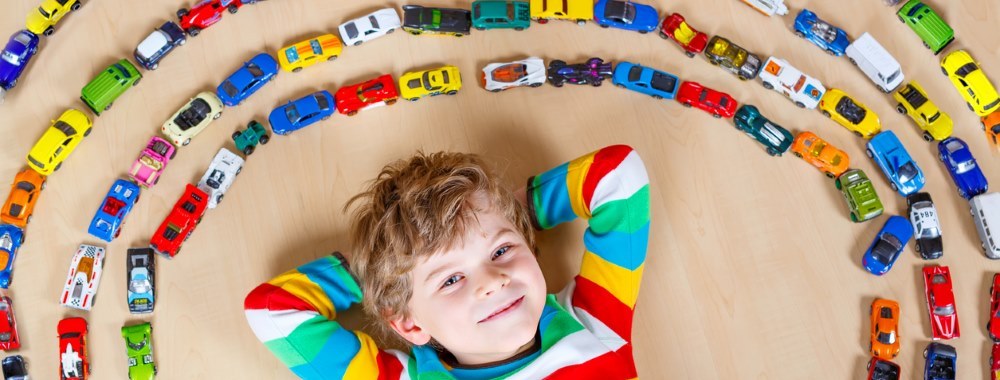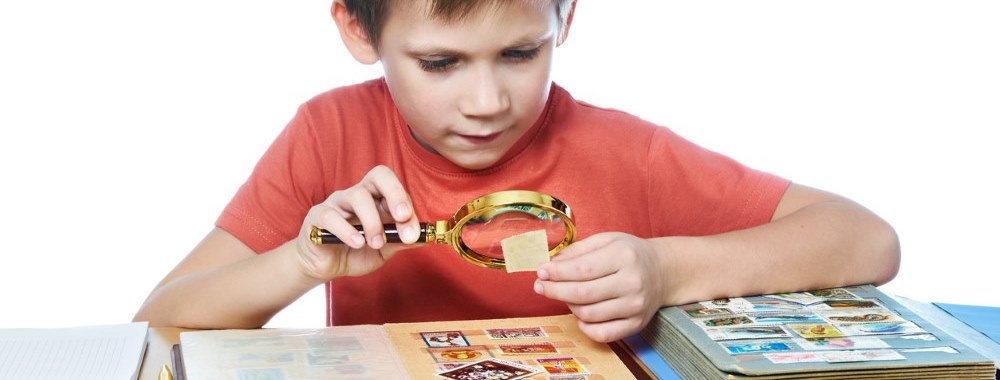How a Child's Desire to Collect Develops Valuable Life Skills

Numismatists, archtophiles and deltiologists all have one thing in common—they all love to collect things, be they coins, teddy bears or postcards.
Collecting is particularly popular among children, whether it’s natural objects like conkers, shells and pebbles, or toys that are intended to be collectibles such as marbles, novelty erasers or the latest playground craze of fidget spinners or Tsum Tsums.
In a survey carried out by Babycentre.com, 79% of parents admitted that their children collected things. 39% of these children gathered objects from nature, 27% were more interested in collecting toys and a further 13% collected other items.
Although parents fear for their bank balance when faced with the news that yet another collectable craze is sweeping the playground, the act of collecting actually benefits children in the following ways.
Social
Collecting is a great way for children to connect and initiate conversation over a common interest. That could be trading football stickers or comparing who has the latest, glitziest unicorn squishie. Such is the power of these collectibles that a child can be elevated to playground celebrity status simply by possessing a ‘rare’ item, especially when they’ve acquired it through luck in a ‘blind pack’—toy manufacturers’ crafty way of ensuring that children buy multiple duplicates in search for an elusive rare edition to complete their collection.
Negotiation
An inevitable part of collecting is the accumulation of duplicates—especially with collectable items sold in blind packs. Although receiving multiples of the same card or toy can be disappointing for children, it does offer the opportunity for trading them with other collectors. This instils an understanding of value—are two common cards equal in value to one rare card?—and enhances negotiation skills. Some children go as far as listing their cards in numerical order to easily identify swaps, developing key mathematical skills.
Organisation
Arranging collections into categories and making decisions about the attributes of different objects helps develop key scientific and mathematical skills. It also enables children to recognise distinctions, which can be a helpful tool in reading.
Patience
Collecting is not instant gratification—there’s a lot of waiting, saving up and ‘earning’ involved. In fact, anticipating an addition to a collection has been scientifically proven to provoke more joy than actually receiving the item. According to research using magnetic resonance imaging (Kuhnen, C. and Knutson, B., 2005), the nucleus accumbens in the brain’s ‘pleasure centre’ erupts with activity when a reward is anticipated. Once this prize is obtained, however, the nucleus accumbens shows less activity, highlighting that the thrill is in the chase.
Responsibility
Fuelled by the desire to complete their collection, children are keen to find ways to ‘earn’ additional items. This gives parents the perfect opportunity to make children responsible for particular household chores—such as tidied bedrooms, completed homework and folded clothes—in return for pocket money to help build their collection.
How collecting can benefit children in the classroom
Collecting items to work towards a bigger prize—known as token economy—is commonly used in the classroom and is seen as a positive way of keeping children on task. Pupils are offered plastic tokens as reward points in exchange for behaving in a certain way. Once a pupil has collected a sufficient number of tokens, he or she can exchange them for a ‘prize’ such as a toy, extra playtime or downtime in class. This token economy has shown to be especially useful for children with additional needs, as the tangible reward—something they can hold and see, rather than just the promise of a house point—helps them understand that their positive behaviour equates to praise.

Getting the best out of collecting
Collecting doesn’t have to mean money down the drain—it can be a cost-free or even lucrative pastime depending on the item the child is collecting. Objects from nature—such as distinctive stones—can be great for children to collect because they’re free, easy to find and can even be decorated to maximise their appeal.
Unique collectibles that tap into a child’s interests, such as model cars or snow globes from around the world, are more likely to turn into a lasting hobby than a generic craze. Stamps, coins and higher-value collectables present potentially profitable pastimes which have the added benefit of requiring an element of additional research.
Unfortunately, if plastic characters or stickers from the latest movie release are the ‘must-have’ item, it’s inevitable that their lure will eventually diminish, at which point once-treasured collectibles suddenly become old news. Although parents have to bite back the urge to say ‘I told you so’, they can take some solace in knowing that their children have developed valuable life skills through the process of collecting.
p { margin-bottom: 20px!important; } h2 { margin-top: 20px!important; }

Numismatists, archtophiles and deltiologists all have one thing in common—they all love to collect things, be they coins, teddy bears or postcards.
Collecting is particularly popular among children, whether it’s natural objects like conkers, shells and pebbles, or toys that are intended to be collectibles such as marbles, novelty erasers or the latest playground craze of fidget spinners or Tsum Tsums.
In a survey carried out by Babycentre.com, 79% of parents admitted that their children collected things. 39% of these children gathered objects from nature, 27% were more interested in collecting toys and a further 13% collected other items.
Although parents fear for their bank balance when faced with the news that yet another collectable craze is sweeping the playground, the act of collecting actually benefits children in the following ways.
Social
Collecting is a great way for children to connect and initiate conversation over a common interest. That could be trading football stickers or comparing who has the latest, glitziest unicorn squishie. Such is the power of these collectibles that a child can be elevated to playground celebrity status simply by possessing a ‘rare’ item, especially when they’ve acquired it through luck in a ‘blind pack’—toy manufacturers’ crafty way of ensuring that children buy multiple duplicates in search for an elusive rare edition to complete their collection.
Negotiation
An inevitable part of collecting is the accumulation of duplicates—especially with collectable items sold in blind packs. Although receiving multiples of the same card or toy can be disappointing for children, it does offer the opportunity for trading them with other collectors. This instils an understanding of value—are two common cards equal in value to one rare card?—and enhances negotiation skills. Some children go as far as listing their cards in numerical order to easily identify swaps, developing key mathematical skills.
Organisation
Arranging collections into categories and making decisions about the attributes of different objects helps develop key scientific and mathematical skills. It also enables children to recognise distinctions, which can be a helpful tool in reading.
Patience
Collecting is not instant gratification—there’s a lot of waiting, saving up and ‘earning’ involved. In fact, anticipating an addition to a collection has been scientifically proven to provoke more joy than actually receiving the item. According to research using magnetic resonance imaging (Kuhnen, C. and Knutson, B., 2005), the nucleus accumbens in the brain’s ‘pleasure centre’ erupts with activity when a reward is anticipated. Once this prize is obtained, however, the nucleus accumbens shows less activity, highlighting that the thrill is in the chase.
Responsibility
Fuelled by the desire to complete their collection, children are keen to find ways to ‘earn’ additional items. This gives parents the perfect opportunity to make children responsible for particular household chores—such as tidied bedrooms, completed homework and folded clothes—in return for pocket money to help build their collection.
How collecting can benefit children in the classroom
Collecting items to work towards a bigger prize—known as token economy—is commonly used in the classroom and is seen as a positive way of keeping children on task. Pupils are offered plastic tokens as reward points in exchange for behaving in a certain way. Once a pupil has collected a sufficient number of tokens, he or she can exchange them for a ‘prize’ such as a toy, extra playtime or downtime in class. This token economy has shown to be especially useful for children with additional needs, as the tangible reward—something they can hold and see, rather than just the promise of a house point—helps them understand that their positive behaviour equates to praise.

Getting the best out of collecting
Collecting doesn’t have to mean money down the drain—it can be a cost-free or even lucrative pastime depending on the item the child is collecting. Objects from nature—such as distinctive stones—can be great for children to collect because they’re free, easy to find and can even be decorated to maximise their appeal.
Unique collectibles that tap into a child’s interests, such as model cars or snow globes from around the world, are more likely to turn into a lasting hobby than a generic craze. Stamps, coins and higher-value collectables present potentially profitable pastimes which have the added benefit of requiring an element of additional research.
Unfortunately, if plastic characters or stickers from the latest movie release are the ‘must-have’ item, it’s inevitable that their lure will eventually diminish, at which point once-treasured collectibles suddenly become old news. Although parents have to bite back the urge to say ‘I told you so’, they can take some solace in knowing that their children have developed valuable life skills through the process of collecting.
p { margin-bottom: 20px!important; } h2 { margin-top: 20px!important; }